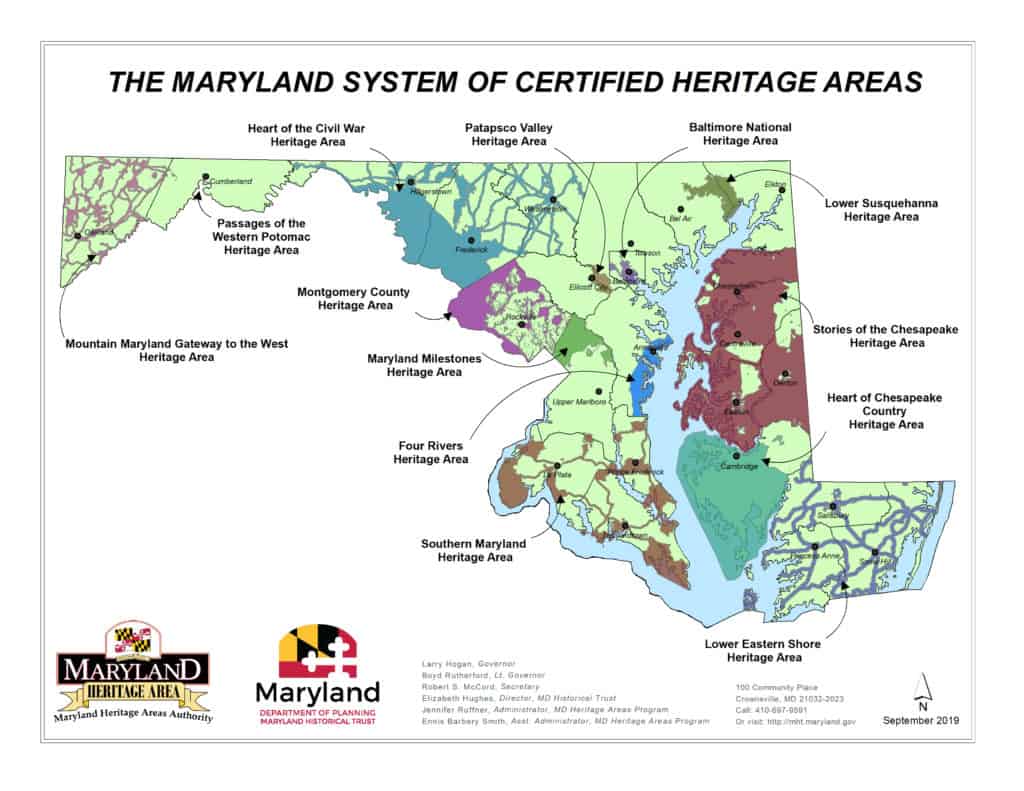Additions proposed to state heritage tourism areas

By Brenda Wintrode
The stewards of three of Maryland’s certified heritage areas are calling on the state to expand their boundaries including one that spans much of Anne Arundel County’s waterfront.
Heritage areas get opportunities for grants, attract history buffs and help boost the state’s tourism economy.
The director of the Four Rivers Heritage Area is presenting a proposal to a state board this week justifying why certain historical assets should be added to the state’s cultural treasure chest.
The 13 certified heritage areas included in the Maryland Heritage Areas Program boasted a $2.4 billion economic impact in 2019 and brought in $319.8 million in state and local taxes, according to a statewide impact study. Heritage area tourists “tend to be overnight visitors; they tend to spend more; they tend to stay longer,” said the program’s administrator Jen Ruffner, which means more dollars going directly back into the Maryland economy.
But before new properties are brought into the revenue-generating fold, the Maryland Heritage Areas Authority (MHAA), the appointed body that oversees the program, must hear public response to the proposals. The state-run board will also consider the potential tourism value of the proposed additions because “if everything’s a heritage area, then nothing’s a heritage area,” Ruffner said.
A public hearing was scheduled for this week to discuss the expansion of the Four Rivers Heritage area that follows the banks of the Chesapeake Bay in Anne Arundel County, and written testimony will be accepted until next Wednesday, April 7.
The 20-year-old heritage area, which includes Annapolis, London Town and South County Heritage Area, is proposing its first-ever boundary amendment that will increase existing boundaries, add two rail trails and the BWI Hiker-Biker Trail; the Mid-County Cluster; and the Jug Bay Cluster.
Proposed boundary amendments must show a historical connection related to the heritage area’s theme. The North County African American Trail winds through Black communities established before the Civil War. The histories of the seven stops in Freetown, Dorsey, Queenstown, Marley Neck, Pumphrey and Furnace Branch were first documented for a bus tour created by the Northern Arundel Cultural Preservation Society.
Two other heritage areas in Maryland, the Heart of the Civil War Heritage Area in Frederick, Washington, and Carroll counties and the Beach to Bay Heritage Area on the lower Eastern Shore, are also proposing expansions. Hagerstown Aviation Museum and Mt. Zion Memorial Church, a circa 1887 historic Black church in Princess Anne, are both on the table for inclusion.
In fiscal year 2020, the MHAA funded 184 grants totaling over $6.1 million. One-third of the grants were emergency funds awarded to nonprofit heritage tourism organizations to cover operating expenses during the COVID-19 crisis.
Ruffner said grant-funded projects must add to a visitor’s experience, for example, by creating interpretive signage for an exhibit or renovating a walking trail.
“Enhancing tourism products that will bring people to Maryland to spend money and support the economy” is the fund’s goal, she said, which will total around $5.1 million this year after budget approval.
Funding must be matched dollar for dollar by an entity other than the state. Capital projects, like renovations, are funded up to $100,000 and non-capital projects, such as research or programs, up to $50,000.
The MHAA is an independent unit of state government that falls under the Department of Planning and is staffed by the Maryland Historical Trust. The MHAA board will not cast their final vote on the proposals until their quarterly public meeting on April 8.
Public comment can be submitted until April 7 in writing to [email protected] or via U.S. mail.
The MHAA quarterly public meeting will be held at 10 a.m. on April 8. To attend visit this link: https://youtu.be/xLxmcBmI4xo . For more: https://mht.maryland.gov/heritageareas.shtml.
April 2021
